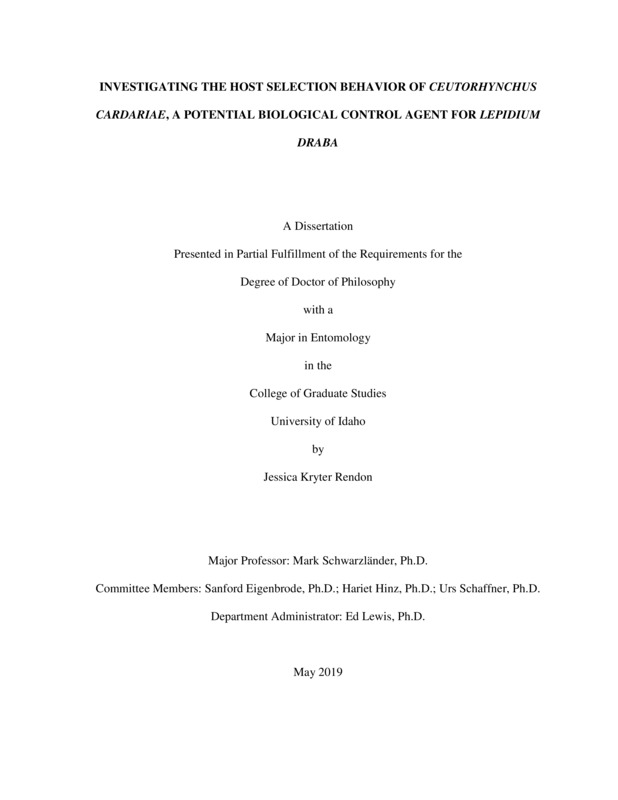INVESTIGATING THE HOST SELECTION BEHAVIOR OF CEUTORHYNCHUS CARDARIAE, A POTENTIAL BIOLOGICAL CONTROL AGENT FOR LEPIDIUM DRABA
Rendon, Jessica Kryter. (2019-05). INVESTIGATING THE HOST SELECTION BEHAVIOR OF CEUTORHYNCHUS CARDARIAE, A POTENTIAL BIOLOGICAL CONTROL AGENT FOR LEPIDIUM DRABA. Theses and Dissertations Collection, University of Idaho Library Digital Collections. https://www.lib.uidaho.edu/digital/etd/items/rendon_idaho_0089e_11525.html
- Title:
- INVESTIGATING THE HOST SELECTION BEHAVIOR OF CEUTORHYNCHUS CARDARIAE, A POTENTIAL BIOLOGICAL CONTROL AGENT FOR LEPIDIUM DRABA
- Author:
- Rendon, Jessica Kryter
- Date:
- 2019-05
- Program:
- Plant, Soil and Entomological Sciences
- Subject Category:
- Entomology
- Abstract:
-
ABSTRACT
Lepidium draba (L.) Desv. (Brassicaceae) is a perennial clonal mustard native to Eurasia that was unintentionally introduced into North America in the late 1800s via seed in ship ballast and via contaminated alfalfa seed from central Asia. The leaf petiole gall-forming weevil, Ceutorhynchus cardariae (Coleoptera, Curculionidae), is an herbivorous insect species considered for the biological control of this invasive plant. Past host-specificity testing data has revealed that under natural field conditions, C. cardariae is a host-specific specialist, but under laboratory, no-choice conditions, its fundamental host range includes two distantly related confamilial species in the genus Streptanthus: S. anceps and S. flavescens. Pre-release host-specificity testing of weed biological control agents can assess which plants are attacked but not why they are attacked. Detailed examination of the pre- and post-alightment behavior on hosts and non-host plants can help determine what plant cues influence host choice by potential agents. To explain the apparent phylogenetically disjunct host range of C. cardariae, I investigated the pre- and post- alightment host-selection behavior and underlying physiological responses of C. cardariae with regard to the visual, volatile, and surface wax cues of L. draba and 13 native North American Brassicaceae genera.
Chapter 1, the introductory chapter, gives detailed background into the study system and rationale for the approach taken in proceeding chapters. Chapter 2 is a literature review on the role of physical and chemical surface wax cues in the host plant selection behavior of herbivore arthropods feeding on Brassicaceae. This review informed me of the importance of surface wax cues in the host selection of several Brassicaceae feeding herbivores, which warranted their examination in my study system. Chapter 3 examines the pre-feeding behavior of C. cardariae on L. draba and one non-host plant, basil. Distinctive pre-feeding behaviors were observed- weevils would drag their antennae along or just above the leaf surface prior to feeding. This suggests that contact chemoreceptors on the weevils’ antennae, and possibly their tarsi, are being used to assess the suitability of the leaf surface. Chapter 4 examines the role of visual, volatile, and contact cues in the host selection behavior of C. cardariae on L. draba. In this chapter, an array of bioassays which manipulated visual, volatile, and surface wax cues of L. draba and plant models were used in a walking arena. The data suggests that C. cardariae mainly relies on visual cues to identify a potential host plant prior to contact, while after contact volatile and contact cues are important for final host recognition. Results also indicate that volatile and contact cues are equally important for final host choice. Chapter 5 examines the similarity of the volatile organic compounds (VOCs) from four different L. draba populations (closely related genetic populations) and 13 native North American confamilial species. A total of 46 VOCs were identified across all plant species but the volatile blends could not be differentiated among plant species using principal component analyses (PCA). PCA among volatile blends of the four populations of L. draba, S. anceps, and S. flavescens only, showed slight separation among the populations and species. Follow-up experiments using gas chromatography-flame ionization detector-electroantennogram detection (GC-FID/EAD) to measure antennal responses in female C. cardariae when exposed to volatile blends of L. draba did not yield any consistent responses.
- Description:
- doctoral, Ph.D., Plant, Soil and Entomological Sciences -- University of Idaho - College of Graduate Studies, 2019-05
- Major Professor:
- Schwarzländer, Mark
- Committee:
- Eigenbrode, Sanford; Hinz, Hariet; Schaffner, Urs
- Defense Date:
- 2019-05
- Identifier:
- Rendon_idaho_0089E_11525
- Type:
- Text
- Format Original:
- Format:
- application/pdf
- Rights:
- In Copyright - Educational Use Permitted. For more information, please contact University of Idaho Library Special Collections and Archives Department at libspec@uidaho.edu.
- Standardized Rights:
- http://rightsstatements.org/vocab/InC-EDU/1.0/

